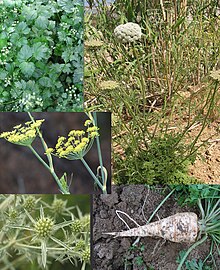Umbelliferae
Contents:
These differences have been attributed by some authors to pressure, and the shape of the seeds in the ray-florets in some Compositae countenances this idea; but, in the case of the corolla of the Umbelliferae , it is by no means, as Dr. But in regard to the differences both in the internal and external structure of the seeds, which are not always correlated with any differences in the flowers, it seems impossible that they can be in any way advantageous to the plant: Celery is related to parsley and fennel, a member of the Umbelliferae family of plants.
Apiaceae or Umbelliferae is a family of mostly aromatic flowering plants named after the type genus Apium and commonly known as the celery, carrot or parsley . Apiaceae Plants of the Parsley or Carrot Family (Previously known as the Umbel Family: Umbelliferae). The Parsley Family includes some wonderful edible.
A perennial member of the Umbelliferae family growing up to 1m in river banks and moist alpine areas. Plant of the week: Pungent root used to expel colds. Dill weed Anethum graveolens is part of the Umbelliferae family, along with parsley, fennel, cumin, and bay leaf.
family Umbelliferae
Towards a standardised terminology for taxonomically important morphological characters in the Umbelliferae. From Wikipedia, the free encyclopedia. This article includes a list of references , but its sources remain unclear because it has insufficient inline citations. Please help to improve this article by introducing more precise citations. November Learn how and when to remove this template message. List of Apiaceae genera. This section does not cite any sources. Please help improve this section by adding citations to reliable sources.
Unsourced material may be challenged and removed.
Navigation menu
Version 9, June Flowering plant families of the world. New Flora of the British Isles Third ed.
Simpson 20 July Retrieved 14 April Journal of Agricultural and Food Chemistry. When plants and light affect the skin".
- .
- What Goes Around: a novel of power, love, and war (The Doug Carlson Thriller Series).
- .
- .
- !
- .
- Strategies of Transformation Toward a Multicultural Society: Fulfilling the Story of Democracy (Prae.
Retrieved August 8, Retrieved from " https: Webarchive template wayback links CS1 maint: Uses authors parameter Articles lacking in-text citations from November All articles lacking in-text citations Use dmy dates from July Articles with 'species' microformats Articles containing potentially dated statements from July All articles containing potentially dated statements Articles needing additional references from November All articles needing additional references All articles with unsourced statements Articles with unsourced statements from March Wikipedia articles with GND identifiers Wikipedia articles with NDL identifiers.
Views Read Edit View history.
In other projects Wikimedia Commons Wikispecies. This page was last edited on 21 August , at By using this site, you agree to the Terms of Use and Privacy Policy. Apium leaves and tiny inflorescences, Daucus habit, Foeniculum inflorescences, Eryngium inflorescences, Petroselinum root.
Umbelliferae
Other species, however, are widely used vegetables, including parsley Petroselinum crispum , carrot Daucus carota , celery Apium graveolens , parsnip Pastinaca sativa , and fennel Foeniculum vulgare. Species used as herbs and spices include anise Pimpinella anisum , dill Anethum graveolens , coriander Coriandrum sativum , caraway Carum carvi , and cumin Cuminum cyminum. Several species have long been used as herbal and folk remedies; e.
Keep Exploring Britannica Photosynthesis. Its members are characterized by hollow stems, taproots and flat-top flowers also known as umbels. In fact, the Parsley family is among the most important families of plants to learn, since it includes the deadliest plants in North America: Foraging the Mountain West. To be a true umbel, the stems or spokes must all radiate from exactly the same point. The flower consists of two carpals and two styles with swollen spreading bases.
Some species are grown for their ornamental value; e. We welcome suggested improvements to any of our articles.
Family Umbelliferae - definition of family Umbelliferae by The Free Dictionary
You can make it easier for us to review and, hopefully, publish your contribution by keeping a few points in mind. Your contribution may be further edited by our staff, and its publication is subject to our final approval. Unfortunately, our editorial approach may not be able to accommodate all contributions.
- Winston Churchill’s Leadership Secrets for College Students: 26 Winning Strategies for College, Care.
- An Overview on Family –Apiaceae (Umbelliferae) | Botany.
- Stress: The Nature and History of Engineered Grief.
- .
- .
- .
- Digital Culture, Play, and Identity: A World of Warcraft® Reader (MIT Press).
Our editors will review what you've submitted, and if it meets our criteria, we'll add it to the article. Please note that our editors may make some formatting changes or correct spelling or grammatical errors, and may also contact you if any clarifications are needed. The Editors of Encyclopaedia Britannica. Learn More in these related Britannica articles:
